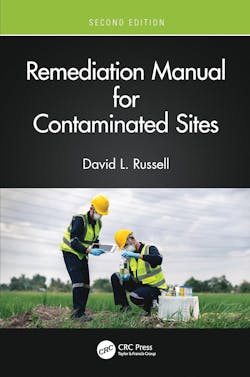Chemical Processing Book Club: Clean Up Contaminated Sites and Hopefully Avoid Lawsuits
Noting that the thirst for economic revenge sometimes outweighs the facts regarding contamination issues, David L. Russell, PE, ASP, president of Global Environmental Operations, Inc., decided to revisit his "Remediation Manual for Contaminated Sites" and publish a second edition, which became available from CRC Press on Aug. 26, 2024.
The manual aims to serve as a guide for tackling the complex challenges of cleaning up contaminated land. Drawing on decades of hands-on experience, Russell offers readers a detailed roadmap covering everything from initial site characterization to innovative remediation techniques and ecosystem restoration.
I asked Russell about his newest book, and he offered these candid answers.
What motivated you to write this book?
I've been in the environmental business for a long time. Over the years, I've noticed that there is a lot of “bad practice” and mistakes leading to very expensive or incomplete cleanups by marginally competent or incompetent practitioners. These activities often result in lawsuits, which does no one except the lawyers any good.
In 2003-2004, I was the principal investigator for the plaintiffs in Aguinda vs. Texaco lawsuit in Ecuador. Texaco was bought out by Chevron, and the trial was conducted under Ecuadorian Law. I left the case in 2004-2005 when it became apparent that the thirst for economic revenge outweighed the facts that the contamination issues were relatively minor and the lawsuit had become divorced from reality.
That experience sparked a desire to expand and improve knowledge in the field, leading to the 2012 publication of “Remediation of Contaminated Sites,” published by CRC Press (Taylor and Francis).
Some 12 years later, I was involved in counseling a group of overseas contractors regarding good practices. The contractors were neophytes, and the level of education was very basic. That led to the current “Remediation Manual for Contaminated Sites” published by CRC Press. This new work reflects some of the basic concepts and adds new materials in biological remediation, use of amendments such as biochar, and also discusses phytoremediation and environmental restoration.
While on the same subject, I believe that the manual is a different book and adds to the body of knowledge and represents experience and good practice.
What are some of the fundamental concepts readers can expect to learn from this book?
This book starts at the beginning of a project and discusses the basic sources for information in the U.S. and internationally and points out to the reader some of the first steps needed to characterize a contaminated site. It discusses tools and techniques and provides guidance on the capabilities of investigation and earth-moving equipment for specific types of remediation. It also contains several useful references and links for more information on related subjects. Specifically, there are chapters on invasive and non-invasive survey techniques, the conduct of the investigation and public relations advice for alleviating the concerns of the residents living near the investigation/cleanup site.
Also discussed are data requirements for planning and QA/QC quality control requirements, barriers and control sections, soil cleanup and restoration of soil vitality, ecosystem restoration, groundwater and well construction, biological treatment of groundwater and soils, phytoremediation and safety in operations.
It is a book for the practicing engineer as a guide to approaching a topic, and it can be used by the experienced professional because it also contains practical tips for managing and improving practice and saving money on remediation.
Can you highlight any challenging topics that your book addresses?
One of the largest headaches is the subject of soil vitality restoration. The recommendations in the book include the use of biochar, compost and approaches to ecosystem restoration. There is also a discussion of problems associated with sample collection and handling on sites where laboratory services may be remote and require special handling and analyses. There is also an outline about what good practice looks like in preparing one's report.
The book also addresses a number of challenges and inadvertent errors made over years of practice and seeks to provide information for the astute reader to help him or her avoid repeating some of the same mistakes. The chapters on Barriers and Control Sections discuss methodologies to control the migration of contaminants in groundwater. The chapters on soil vitality restoration are important, especially after thermal treatment of the soils. There are two separate chapters on data handling, one aimed at field operations and the second aimed at laboratory analyses. The chapter on ecosystem restoration is loosely based on recommendations by the UN Environmental Program but contains practical techniques for achieving ecosystem restoration goals.
The overall goal of this work is to provide a guide for the novice and for the practicing engineer.
Please share any practical examples or case studies that readers might find valuable.
Even after 20 years, one incident stands out. While in Ecuador in 2004, we could not locate an in-country laboratory with the analytical capabilities required for soil analyses. We had to send samples back to the U.S. for analysis. We provided the necessary paperwork to clear the samples for the laboratory, but we did not count on U.S. Customs holding the samples for four days, breaking the chain of custody seals, opening some of the sealed soil samples for inspection and effectively violating any chain of custody protocols for admission of data in a court proceeding. It was an expensive lesson that could have been avoided.
Apart from your book, what other resources or references do you recommend to readers who want to continue learning about this topic?
One of the challenges for anyone providing internet references for further research is the changing nature of the internet. In preparing this work, I made a concerted effort to investigate previous reference sites and found that many links were changed or no longer valid. I have attempted to correct the internet references by providing links to sites that may not change in the future. I have attempted to make this change by referring to larger sites and governmental agencies that appear stable. In one instance, I even called the HACH Chemical helpline and asked them to restore an archived document to an active website because it contained helpful information for the practitioner.
As a guide to data handling and presentation, I have also provided a challenge. I constructed a data package that contained boring logs and chemical contaminants. It can be solved with commercial software, and it is designed to help the reader with a practical exercise on what some of these sites look like before actually handling the data for one. It would be useful for faculty as a training aide on groundwater investigations.
There are many other resources available from various governments. I have attempted to include references and materials that apply to U.S. and non-U.S. practitioners. The Manual is not U.S.-centric but can be used by practitioners worldwide. Governmental organizations often publish helpful publications on a variety of environmental topics. I have attempted to provide the reader with locations for further investigation by using those sites.
Have you received any feedback from readers or professionals in the field about how your book has helped them?
I have received feedback from several other sources, and they tell me that the book is needed and necessary for remediation practitioners. Many of the comments received have been from sources outside the U.S., where remediation practice is slightly different.
What impact do you hope your book will have on readers?
While writing this book, I was working on a project to clean up soils in Nigeria. Much of the practice and guidance in the book was based on the needs of some Nigerian contractors.
I hope that this book will be used in civil engineering, environmental engineering and chemical engineering to instruct and inform students about proper practice. It might also be a good textbook for teaching remediation.
About the Author
Traci Purdum
Editor-in-Chief
Traci Purdum, an award-winning business journalist with extensive experience covering manufacturing and management issues, is a graduate of the Kent State University School of Journalism and Mass Communication, Kent, Ohio, and an alumnus of the Wharton Seminar for Business Journalists, Wharton School of Business, University of Pennsylvania, Philadelphia.


